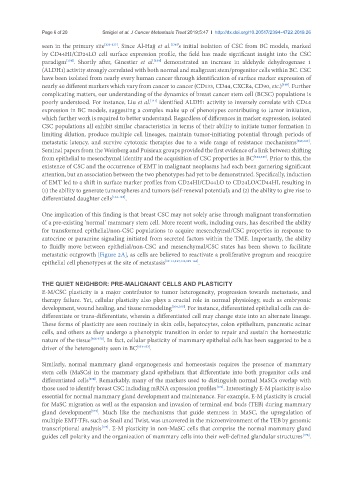Page 341 - Read Online
P. 341
Page 6 of 20 Smigiel et al. J Cancer Metastasis Treat 2019;5:47 I http://dx.doi.org/10.20517/2394-4722.2019.26
seen in the primary site [135-137] . Since Al-Hajj et al. ’s initial isolation of CSC from BC models, marked
[138]
by CD44HI/CD24LO cell surface expression profile, the field has made significant insight into the CSC
paradigm . Shortly after, Ginestier et al. demonstrated an increase in aldehyde dehydrogenase 1
[138]
[139]
(ALDH1) activity strongly correlated with both normal and malignant stem/progenitor cells within BC. CSC
have been isolated from nearly every human cancer through identification of surface marker expression of
nearly 40 different markers which vary from cancer to cancer (CD133, CD44, CXCR4, CD90, etc.) . Further
[140]
complicating matters, our understanding of the dynamics of breast cancer stem cell (BCSC) populations is
poorly understood. For instance, Liu et al. identified ALDH1 activity to inversely correlate with CD44
[141]
expression in BC models, suggesting a complex make up of phenotypes contributing to tumor initiation,
which further work is required to better understand. Regardless of differences in marker expression, isolated
CSC populations all exhibit similar characteristics in terms of their ability to initiate tumor formation in
limiting dilution, produce multiple cell lineages, maintain tumor-initiating potential through periods of
metastatic latency, and survive cytotoxic therapies due to a wide range of resistance mechanisms [142,143] .
Seminal papers from the Weinberg and Puisieux groups provided the first evidence of a link between shifting
from epithelial to mesenchymal identity and the acquisition of CSC properties in BC [144,145] . Prior to this, the
existence of CSC and the occurrence of EMT in malignant neoplasms had each been garnering significant
attention, but an association between the two phenotypes had yet to be demonstrated. Specifically, induction
of EMT led to a shift in surface marker profiles from CD24HI/CD44LO to CD24LO/CD44HI, resulting in
(1) the ability to generate tumorspheres and tumors (self-renewal potential); and (2) the ability to give rise to
differentiated daughter cells [144-148] .
One implication of this finding is that breast CSC may not solely arise through malignant transformation
of a pre-existing ‘normal’ mammary stem cell. More recent work, including ours, has described the ability
for transformed epithelial/non-CSC populations to acquire mesenchymal/CSC properties in response to
autocrine or paracrine signaling initiated from secreted factors within the TME. Importantly, the ability
to fluidly move between epithelial/non-CSC and mesenchymal/CSC states has been shown to facilitate
metastatic outgrowth [Figure 2A], as cells are believed to reactivate a proliferative program and reacquire
epithelial cell phenotypes at the site of metastasis [12-14,137,141,149-163] .
THE QUIET NEIGHBOR: PRE-MALIGNANT CELLS AND PLASTICITY
E-M/CSC plasticity is a major contributor to tumor heterogeneity, progression towards metastasis, and
therapy failure. Yet, cellular plasticity also plays a crucial role in normal physiology, such as embryonic
development, wound healing, and tissue remodeling [164,165] . For instance, differentiated epithelial cells can de-
differentiate or trans-differentiate, wherein a differentiated cell may change state into an alternate lineage.
These forms of plasticity are seen routinely in skin cells, hepatocytes, colon epithelium, pancreatic acinar
cells, and others as they undergo a phenotypic transition in order to repair and sustain the homeostatic
nature of the tissue [166-170] . In fact, cellular plasticity of mammary epithelial cells has been suggested to be a
driver of the heterogeneity seen in BC [171-173] .
Similarly, normal mammary gland organogenesis and homeostasis requires the presence of mammary
stem cells (MaSCs) in the mammary gland epithelium that differentiate into both progenitor cells and
differentiated cells . Remarkably, many of the markers used to distinguish normal MaSCs overlap with
[174]
those used to identify breast CSC including mRNA expression profiles . Interestingly E-M plasticity is also
[174]
essential for normal mammary gland development and maintenance. For example, E-M plasticity is crucial
for MaSC migration as well as the expansion and invasion of terminal end buds (TEB) during mammary
gland development . Much like the mechanisms that guide stemness in MaSC, the upregulation of
[174]
multiple EMT-TFs, such as Snail and Twist, was uncovered in the microenvironment of the TEB by genomic
transcriptional analysis . E-M plasticity in non-MaSC cells that comprise the normal mammary gland
[175]
guides cell polarity and the organization of mammary cells into their well-defined glandular structures .
[176]

